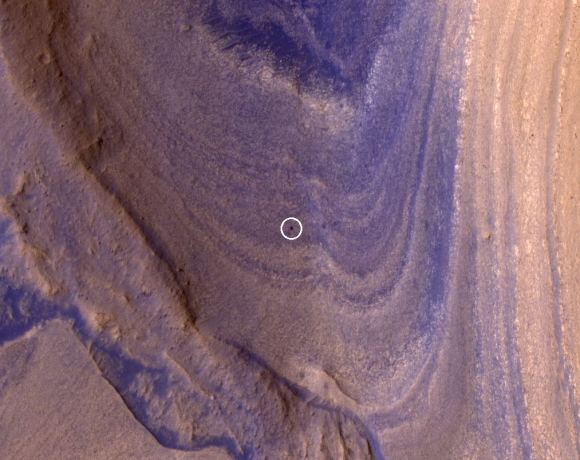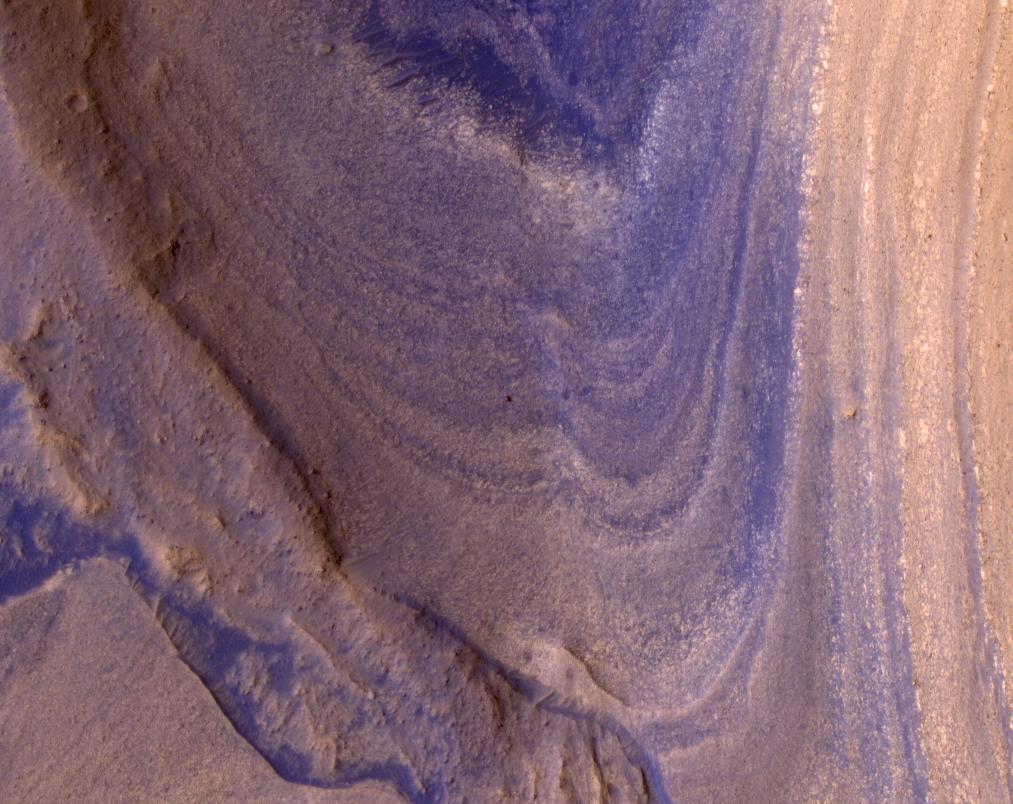Just about every day we here on Earth get a breathtaking picture of Mars’s terrain sent back by a rover. But, the view from space can be pretty amazing, too. The Mars Reconnaissance Orbiter (MRO) just sent back a thought-provoking picture of Curiosity as it makes its way up a steep ridge on Mount Sharp.
The rover is a tiny black dot in the center of the image, which gives a good feeling for what MRO’s HiRISE camera accomplished. For scale, the rover is about the size of a dinner table, sitting in a region of alternating dark and light bands of material on the Red Planet.

Where’s Curiosity?
The Curiosity rover is exploring an ancient ridge on the side of Mount Sharp, which is the peak of a crater on Mars. It’s sitting on the side of a feature called Gediz Vallis Ridge, and the terrains and materials preserve a record of what things were like when water last flowed there. That happened about three billion years ago. The force of the flow brought significant amounts of rocks and debris through the region. They piled up to form the ridge. So, much of what you see here is the desiccated remains of that flooding.
Debris flows are pretty common here on Earth, particularly in the aftermath of floods, volcanic eruptions, tsunamis, and other actions. We can see them wherever material floods through a region or down a slope. In a flood-based flow, the speed of the water combines with gravity and the degree of slope to send material rushing across the surface. A debris flow can also be a dry landslide, and those can occur pretty much anywhere on Earth where the conditions are right. Another type of debris flow comes from volcanic activity. That occurs when material erupts from a volcano, or when earthquakes combined with an eruption collapse material into the side of the mountain. That results in what’s called a “lahar”. Folks in North America might recall the Mount St. Helens eruption in 1980; it resulted in several lahars that buried parts of the surrounding terrain.
Now that scientists see similar-seeming regions on Mars, they want to know several things. How did they form? Were they created by the same processes that make them on Earth? And, how long ago did they begin to form? Curiosity and Perseverance and other rovers and landers have been sent to Mars to help answer those questions.
Understanding the Debris Ridge
Did any of these actions happen on Mars? The evidence is pretty strong, which is why Gediz Vallis itself is a major exploration goal for the rover. It’s a canyon that stretches across 9 kilometers of the Martian surface and is carved about 140 meters deep. Gediz was likely carved by so-called “fluvial” activity (meaning flowing action) in the beginning. Later floods deposited a variety of fine-grained sands and rocks. Over time, winds have blown a lot of that material away, leaving behind protected pockets of materials left behind by the flooding. The size of the rocks tells something about the speed of the flows that deposited all the material. Geological studies of those rocks will reveal their mineral compositions, including their exposure to water over time.
The Gediz Vallis ridge resulted from the action of water pushing rocks and dirt around to build it up over time. Planetary scientists now need to figure out the sequence of events that created it. The clues lie in the scattered rocks in the region and the surrounding terrain. Mount Sharp itself (formally known as Aeolis Mons), is about 5 kilometers high and is, essentially, a stack of layered sedimentary rocks. As Curiosity makes its way up the mountain, it explores younger and younger materials.

Curiosity’s Mission at Gediz
To put all this on a larger scale, Mount Sharp is the central peak of Gale Crater. It formed some 3.5 to 3.8 billion years ago from an impact. As time went by, water flooded the crater several times. It flowed out and eventually disappeared as Mars’s climate changed it to the dusty desert we see today.
Winds also played a role in filling the crater with dust and sand deposits. This so-called aeolian activity also helped carve out Mount Sharp. This history of wind- and water-based deposition and erosion made Gale Crater a very attractive place to explore. That’s why Curiosity was sent there and continues its journey up Mount Sharp.
For More Information
HiRISE Spots Curiosity Driving Toward Upper Gediz Vallis
Curiosity Views Gediz Vallis Ridge
The Gediz Vallis Inverted Channel: Evidence for Late-state Flow in Gale Crater, Mars?

